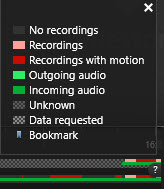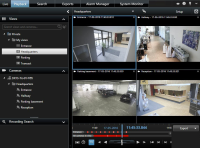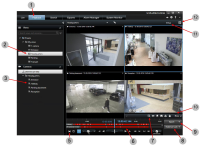Investigating incidents
You investigate incidents mainly on the Playback tab by using the timeline to browse recorded video. To view recorded video, you must find a view that shows video from the cameras that you are interested in. The views are available in the Views pane. For each camera that appears in a view, different actions are available, for example taking snapshots or launching search. See also Camera toolbar (overview). If something catches your attention, you can zoom in to take a closer look using the virtual joystick.
You can perform advanced searches on the Search tab and use the search results as a starting point for further investigation or actions, for example exporting and bookmarking.
If the incident is associated with an alarm, go to the Alarm Manager tab, or select a view where the Alarm List has been added.
If you have an Incidents tab in Smart Client, you have XProtect® Incident Manager![]() Product available as an add-on to XProtect surveillance systems. With XProtect Incident Manager, you can document and manage incidents within XProtect Smart Client..
Product available as an add-on to XProtect surveillance systems. With XProtect Incident Manager, you can document and manage incidents within XProtect Smart Client..
Viewing recorded video (explained)
There are different ways of viewing recorded video:
On the Playback tab
On the Playback tab, all cameras in a view display recordings from the same point in time, the master time. You can play back or browse recordings by using the timeline. See also Time navigation controls (overview).
However, you can also view and navigate recordings from individual cameras independently of the master time. Independent playback must be enabled in the Functions settings. See also Functions settings.
If you are accessing your cameras through the tree structure in the Cameras pane, you can open individual cameras in a new window from the Playback tab.
On the Live tab
Though the Live tab normally shows live video, you can watch recorded video for individual cameras by clicking the ![]() button in the camera toolbar. This will open a new window where you can play back or browse the recordings. Camera playback must be enabled. See also Functions settings.
button in the camera toolbar. This will open a new window where you can play back or browse the recordings. Camera playback must be enabled. See also Functions settings.
On the Search tab
The search results are basically video sequences that you can play back:
- Preview the search results. See also Preview video from search results
- Play back the search results in full screen mode or in a separate window. See also Open search results in separate windows
Playback tab (overview)
| Number | Description |
|---|---|
|
1 |
View recorded video on the Playback tab. |
|
2 |
Select a view in the tree structure or use keyboard shortcuts. See also Keyboard shortcuts (overview). |
|
3 |
Change individual cameras temporarily. See also Change individual cameras temporarily. |
|
5 |
Select a time span for exporting video. See also Time navigation controls (overview). |
|
6 |
Browse using the timeline. See also Timeline (explained). |
|
7 |
Open a new search window with the camera preselected. See also Start search from cameras or views. |
| 8 |
Create an evidence lock. |
| 9 |
Export video data. See also Export video, audio, and still images. |
| 10 |
Perform various actions on the camera toolbar. See also Camera toolbar (overview). |
| 11 |
Enter or exit setup mode to add cameras and other types of content to your views. |
| 12 | Switch to full screen mode. |
Timeline (explained)
The timeline displays an overview of periods with recordings from all cameras displayed in your current view. Two timelines are displayed in the timeline area:
- The upper timeline shows the recording periods of the selected camera
- The lower timeline is for all the cameras in the view, including the selected camera. If you have linked floating windows, these will also be included on the lower timeline
- Drag the timeline to the right or left to move in time, or use the scroll wheel of your mouse.
- To adjust the range of the timeline, press CTRL and use the scroll wheel at the same time.
You will see these colors in the timeline:
- Light-red indicates recordings
- Red indicates motion
- Light green indicates outgoing audio
- Green indicates incoming audio
For a legend of the color codes, to the far right, click the small question mark.

If there are additional sources of data available in your XProtect VMS system, incidents from these sources are shown as markers in other colors. The incidents can appear as pop-ups in the timeline.

To view markers and colors from additional sources, Additional data and Additional markers must either be enabled in the timeline settings or server-side by your system administrator. See also Timeline settings.
Bookmarks in the timeline (explained)
Bookmarks in the timeline are indicated with a blue bookmark icon:  . To view the bookmarked video, place your mouse over the icon.
. To view the bookmarked video, place your mouse over the icon.
Time navigation controls (overview)
| Number | Description |
|---|---|
|
1 and 3 |
The playback date and time is the time to which all the cameras are tied. When you play back recordings, all cameras in the view will show video from the same time. Some cameras, however, may only record if motion is detected. Also, there may be no recorded video from one or more cameras in the view matching the specified point in time. Then, the last image in the database prior to the specified point in time will be dimmed. |
|
2 |
The time of the timeline is indicated by a blue vertical line. |
|
4 |
|
|
5 |
|
|
6 |
The playback speed slider lets you change the current playback speed. Move the slider to the left for slow motion, and to the right for fast motion. Click 1x for normal speed. |
|
7 |
 Move to the image just before the one currently viewed. Move to the image just before the one currently viewed. |
| 8 |
|
| 9 |
|
| 10 |
 Play forward in time. Play forward in time. |
| 11 |
 Move to the image just after the one currently viewed. Move to the image just after the one currently viewed. |
| 12 |
 Move to the first image in the database for the selected camera. Move to the first image in the database for the selected camera. |
| 13 |
 Move to the first image in the previous sequence. Move to the first image in the previous sequence. |
| 14 |
 Move to the first image in the following sequence. Move to the first image in the following sequence. |
| 15 |
 Move to the last image in the database for the selected camera. Move to the last image in the database for the selected camera. |
| 16 |
 Specify the time span of playback in the timeline. Specify the time span of playback in the timeline. |
View recorded video independently of timeline
When you play back video on the Playback tab, all recordings in the view are synchronized with the timeline. For individual cameras, you can play back video independently of the timeline.
You can only use this feature for ordinary single-camera positions, not for hotspots, carousels, or Matrix positions.
In the Settings window > Functions tab, the Independent playback option must be set to Available.
Steps:
- Move your cursor to the bottom of the camera that you want to view recorded video from. On the toolbar that appears, click the Independent playback button.

The independent playback timeline appears:
- Drag the timeline to set the start time.
- To view recorded video for the selected time on all the cameras in your view at once, on the toolbar, click the Use the selected time on the playback timeline button:
 . This displays the Playback tab with all cameras synchronized to the time you have selected.
. This displays the Playback tab with all cameras synchronized to the time you have selected.
Investigate your search results
There are different ways of investigating incidents that you have found on the Search tab:
- Open the search result in a separate window where the Playback tab is preselected. See also Open search results in separate windows
- Open the search result in a detailed view. Do one of the following:
- In the list of search results, double-click the search result to view it in full screen mode. Double-click again to return to the list of search results
- If you are previewing your search result in the preview area, double-click inside the video image. The search result opens in full screen mode. Double-click again to return to the preview area






 Select a period of time by dragging the start and end time indicators on the timeline - typically when you are exporting video. Click again to see the timeline with no time selected.
Select a period of time by dragging the start and end time indicators on the timeline - typically when you are exporting video. Click again to see the timeline with no time selected. Jump to a specific point in time by specifying the date and time.
Jump to a specific point in time by specifying the date and time. Play backward in time.
Play backward in time.  When you click either
When you click either  Adjust the speed. Drag it to the right to increase forward play speed. Drag to the left to increase backward play speed.
Adjust the speed. Drag it to the right to increase forward play speed. Drag to the left to increase backward play speed.